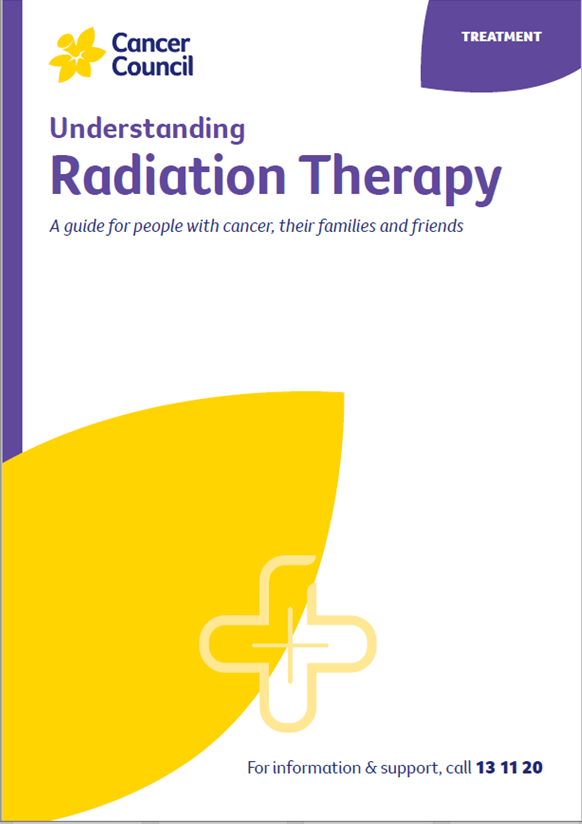- Home
- Cancer of the uterus
- Treatment
- Radiation therapy
Radiation therapy for cancer of the uterus
Also known as radiotherapy, radiation therapy uses a controlled dose of radiation to kill or damage cancer cells so they cannot grow, multiply or spread. The radiation is usually in the form of x-ray beams. Treatment is carefully planned to limit damage to the surrounding healthy tissues.
Learn more about:
- Overview
- Internal radiation therapy (brachytherapy)
- External beam radiation therapy
- Side effects of radiation therapy
- Video: What is radiation therapy?
Overview
For cancer of the uterus (endometrial cancer), radiation therapy is commonly used as an additional treatment after surgery to reduce the chance of the disease coming back. This is called adjuvant therapy.
In some cases, radiation therapy may be recommended as the main treatment (e.g. when other health conditions mean you are not well enough for a major operation).
There are 2 main ways of delivering radiation therapy: internally and externally. Some people are treated with both types of radiation therapy. Your radiation oncologist will recommend the course of treatment most suitable for you.
Internal radiation therapy (brachytherapy)
Internal radiation therapy may be used after a hysterectomy to deliver radiation directly to the top of the vagina (vaginal vault) from inside your body. This is known as vaginal vault brachytherapy.
During each treatment session, a plastic cylinder (the applicator) is inserted into the vagina. The applicator is connected by plastic tubes to a machine that contains a small, radioactive seed (made of metal). Next, this seed moves from the machine into the applicator where it delivers a targeted dose of radiation to the area affected by cancer. After a few minutes, the seed is drawn back into the machine. The applicator is taken out of the vagina after each session.
This type of brachytherapy does not need any anaesthetic. Each treatment session usually takes only 20–30 minutes. You are likely to have 3–6 treatment sessions as an outpatient over 1–2 weeks.
If you are having radiation therapy as the main treatment and haven’t had a hysterectomy, the internal radiation therapy may involve placing an applicator inside the uterus. This is done under anaesthetic or sedation, and may require a short hospital stay.
External beam radiation therapy
External beam radiation therapy (EBRT) directs the radiation at the cancer and surrounding tissue from outside the body. For cancer of the uterus, the lower abdomen and pelvis are treated, but if the cancer has spread (metastasised), other areas may also be treated.
Planning for EBRT may involve several visits to your doctor to have more tests, such as blood tests and scans. Your radiation therapy team will give you instructions on preparing your bowel and bladder before planning scans and treatment sessions.
Each EBRT session lasts about 30 minutes, with the treatment itself taking only a few minutes. You will lie on a treatment table under a large machine known as a linear accelerator, which delivers the radiation. The treatment is painless (like having an x-ray) but may cause side effects.
If you are having EBRT, you will probably have daily treatments, Monday to Friday, for 5–6 weeks as an outpatient. It’s very important that you attend all of your scheduled sessions to ensure you receive enough radiation to make the treatment effective.
Learn more about radiation therapy.
→ READ MORE: Side effects of radiation therapy
Video: What is radiation therapy?
Watch this short video to learn more about radiation therapy.
Podcast: Making Treatment Decisions
Listen to more episodes from our podcast for people affected by cancer
More resources
A/Prof Orla McNally, Consultant Gynaecological Oncologist, Director Oncology/Dysplasia, Royal Women’s Hospital, Honorary Clinical Associate Professor, University of Melbourne, and Director of Gynaecology Tumour Stream, Victorian Comprehensive Cancer Centre, VIC; A/Prof Yoland Antill, Medical Oncologist, Peninsula Health, Parkville Familial Cancer Centre, Cabrini Health and Monash University, VIC; Grace Guerzoni, Consumer; Zeina Hayes, 13 11 20 Consultant, Cancer Council Victoria; Bronwyn Jennings, Gynaecology Oncology Clinical Nurse Consultant, Mater Hospital Brisbane, QLD; A/Prof Christopher Milross, Director of Mission and Radiation Oncologist, Chris O’Brien Lifehouse, NSW; Mariad O’Gorman, Clinical Psychologist, Liverpool Cancer Therapy Centre and Bankstown Cancer Centre, NSW.
View the Cancer Council NSW editorial policy.
View all publications or call 13 11 20 for free printed copies.
Need to talk?
Support services
Exercise and cancer
Learn exercises that can help you with side effects, speeding up recovery, and improving your quality of life
Online Community
Check out this supportive online community for people affected by cancer
Cancer information
Common questions about radiation therapy
Key questions about radiation therapy as part of cancer treatment
Making cancer treatment decisions
Decision-making steps, consent and second opinions

